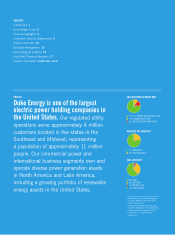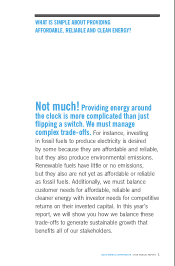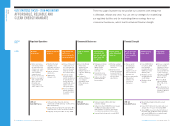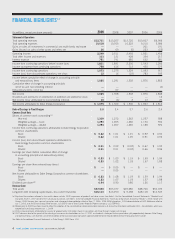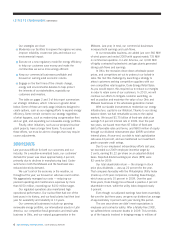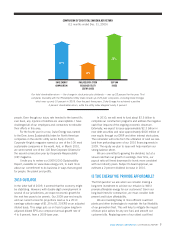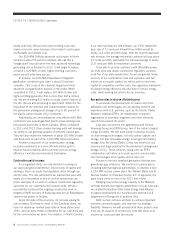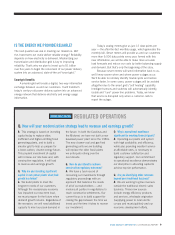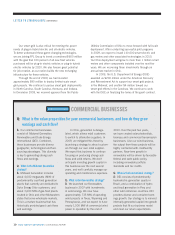Duke Energy 2009 Annual Report Download - page 10
Download and view the complete annual report
Please find page 10 of the 2009 Duke Energy annual report below. You can navigate through the pages in the report by either clicking on the pages listed below, or by using the keyword search tool below to find specific information within the annual report.
DUKE ENERGY CORPORATION / 2009 ANNUAL REPORT 9
STRATEGIC FOCUS REGULATED OPERATIONS
IS THE ENERGY WE PROVIDE RELIABLE?
The next question we ask in meeting our mission is: Will
the investments we make deliver reliable energy? Reliability
depends on how electricity is delivered. Modernizing our
transmission and distribution grid is key to improving
reliability. That’s why we plan to invest up to $1 billion
over five years to begin the conversion of our power delivery
system into an advanced, state-of-the-art “smart grid.”
Smart grid benefits
A smarter grid will create a digital, two-way information
exchange between us and our customers. It will transform
today’s century-old power delivery system into an advanced
energy network that delivers electricity and energy usage
information.
Today’s analog meters give us just 12 data points per
year — the after-the-fact monthly usage, which generates the
monthly bill. Smart meters will provide us and our customers
more than 9,000 data points every year. Armed with this
new information, we will be able to make more accurate
load forecasts and reduce our costs by better balancing supply
and demand. But that’s only the beginning of the story.
Because smart meters will send information back to us,
we’ll know sooner when and where power outages occur.
We’ll be able to remotely identify trouble spots and restore
service faster. In some cases, power outages will be avoided
altogether due to the smart grid’s “self healing” capability.
Intelligent sensors and switches will automatically identify,
isolate and “cure” power line problems. Today, we know
that service is disrupted only when a customer calls to
report the outage.
A: This strategy is based on investing
capital today to replace older,
inefficient and higher-emitting fossil
generating plants, and to build a
smarter grid to help us prepare for
a lower-carbon, cleaner-energy future.
This prudent investment of capital
will increase our rate base and, with
constructive regulation, it will lead
to revenue and earnings growth.
Q: Why are you investing significant
capital in new power plants when load
growth has fallen?
A: We build plants to meet the
long-term needs of our customers.
Although the recessionary economy
has impacted our near-term load,
we must prepare for the future when
demand growth returns. Regardless of
the recession, we will need additional
capacity to meet our peak demand in
the future. In both the Carolinas and
the Midwest, we have not built a new
baseload power plant since the 1980s.
The new cleaner-coal and gas-fired
generating units we are building
will replace the older fossil plants
we anticipate retiring over the
next decade.
Q: How do you intend to achieve
constructive regulatory outcomes?
A: We have a track record of
recovering our investments through
regulatory proceedings with an
approach that balances the needs
of all of our stakeholders — and
involves all parties in negotiations to
reach constructive settlements. Our
current focus is to build support for
closing the gap between the time we
invest and the time it takes to recover
our investment.
Q: Why is operational excellence
significant for meeting financial goals?
A: Operating our plants and system
with high availability and efficiency,
while also providing excellent service
at affordable rates, is necessary to
build customer satisfaction and
regulatory support. Our commitment
to operational excellence demonstrates
our discipline in allocating capital to
achieve top-tier performance.
Q: Are you identifying other revenues
beyond your traditional business?
A: We are working to grow revenues
outside the traditional electric sales
business. These new sources
include energy efficiency products
and services, wholesale origination
(supplying power to rural electric
co-ops and municipalities) and our
economic development efforts.
Q: How will your modernization strategy lead to revenue and earnings growth?


